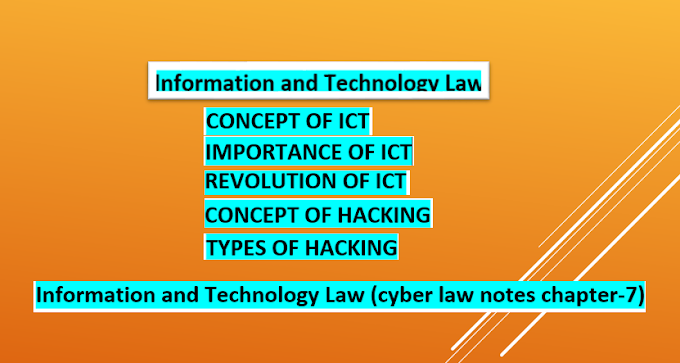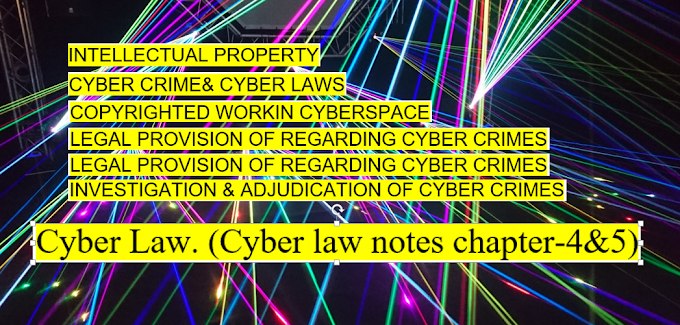INTELLECTUAL PROPERTY:
Intellectual Property is a term for various legal
entitlements. It includes written text, recorded media and Inventions. The
holders of these legal entitlements are entitled to exercise various exclusive
rights in relation to the subject matter of the Intellectual Property. The term
Intellectual property reflects the idea that it is the product of the mind or the
Intellect.
The enforcement of Intellectual property Laws varies from
jurisdiction to jurisdiction. Inter-governmental efforts are essential to
harmonize the law through international treaties. Intellectual property rights
is a legal rights. Intellectual Property laws confer a bundle of exclusive
rights in relation to the particular manner of Intellectual property. The term
intellectual property denotes the specific legal rights that authors,
inventors, and other Intellectual Property holders may hold and exercise.
TYPES OF INTELLECTUAL PROPERTY:
There are Six Types of Intellectual Properties:
- • Copyright
- • Patents
- • Trademarks
- • Industrial Designs
- • Geographical Indications
- • Trade secrets
Copyright
Copyright is a legal term used to describe the rights that
creators have over their literary and artistic works. Works covered by copyright
range from books, music. Paintings, sculptures and films, to computer programs,
databases, advertisements, maps and technical drawings.
Patents
A patent is an exclusive right granted for an invention.
Generally speaking, a patent provides the patent owner with the right to decide
how - or whether – the invention can be used by others. In exchange for this
right, the patent owner makes technical information about the invention
publicly available in the published patent document.
Trademarks
A trademark is a sign capable of distinguishing the goods or
services of one enterprise from those of other enterprises. Trademarks date
back to ancient times when artisans used to put their signature or
"mark" on their products.
Industrial designs
An industrial design constitutes the ornamental or aesthetic
aspect of an article. A design may consist of three-dimensional features, such
as the shape or surface of an article, or of two-dimensional features, such as
patterns, Iines or color.
Geographical indications
Geographical indications and appellations of origin are
signs used on goods that have a specific geographical origin and possess
qualities, a reputation or characteristics that are essentially attributable to
that place of origin. Most commonly, a geographical indication includes the
name of the place of origin of the goods.
Trade secrets
Trade secrets are IP rights on confidential information
which may be sold or licensed. The unauthorized acquisition, use or disclosure
of such secret information in a manner contrary to honest commercial practices
by others is regarded as an unfair practice and a violation of the trade secret
protection.
NATURE OF THE COPYRIGHTED WORK IN CYBERSPACE
This factor will generally weigh in favor of fair use if the
work to be used is factual in nature (scholarly, technical, scientific, etc.),
as opposed to works involving more creative expression, such as plays, poems,
fictional works, photographs, paintings, and so on. Fair use does not apply to
some works, such as standardized tests, workbooks, and works that are meant to
be consumed. The case for fair use becomes even stronger when there are only a
few ways to express the ideas or facts contained in a factual work. The line
between unprotected "facts and ideas" on the one hand and protected
"expression" on the other, is often difficult to draw. If there is
only one way or very few ways to express a fact or an idea, the expression is
said to have merged into the fact/idea, and there is no copyright protection
for the expression.
Fair use applies to unpublished works as it does to
published works, but the author's rights of first publication may be a factor
weighing against fair use if a work is unpublished.
CYBER CRIME& CYBER LAWS:
Cyber Crime covers offenses where a computer or Other CT
tools are used to commit an offense. The actual offense committed may be a
traditional offense, These are theft, fraud, identity crimes, harassment,
threatening violence, child possessing, making, or distributing objectionable
material, e.g. child pornography, criminal breach of copyright.
Cyber Crime is a type of offense specifically related to
computers. Hacking, unauthorized access to a computer system, distributing an
electronic virus designed to damage or accesses a computer system, is
distributing software for the commission of a crime, Launching a denial of service
attack intentionally or causing a computer system to deny to any authorized
user. So we defined it as
"Cyber crimes are almost conventional crimes in nature
committed by using computers & ICT with an intension to make social
disorder."
The followings are the Cyber Crimes:
1. 1. Financial Crimes
2.
Cyber Pornography
3.
Sale of Illegal Article
4.
Online Gambling
5.
Intellectual Property
Crimes
6.
Email Spoofing
7.
Forgery
8.
Cyber Defamation
9.
Cyber Stalking
Technical Cyber Crimes:
There is another kind of Cyber Crime that is called
technical Cyber Crime. These are classified as follows:
1. 1. Unauthorized access
2.
Theft of Information
3.
Email Bombing
4.
Data Diddling
5.
Salami Attack
6.
Denial of Service Attack
7.
Virus Attack
8.
Worms Attack
9.
Logic Bombs
10.
Trojan Attack
11.
Internet time theft
12.
Web Jacking
13.
Theft of Computer System
14.
Physically Damaging of a
Computer System.
LEGAL PROVISIONS OF REGARDING CYBER CRIMES
In order to facilitate e-commerce and encourage the growth
of IT. The government of Bangladesh enacted the ICT Act-2006, ICT Act-2013 and
Digital Security Act-2018 making provisions with a maximum punishment of life imprisonment
or a fine up to taka 5 crores or both. However, the Digital Security Act-2018,
raised penalties for cyber-crimes setting a punishment for offenses as
cognizable and non-bailable, empowering law enforcers to arrest anyone accused of
violating the law without a warrant, by invoking section 54 of the Code of Criminal
Procedure. All such offenses were non-cognizable in the ICT Act-2006. However,
all concerned apprehend of the misuse of the power by the police.
In regard to law enforcement, Interpol has provided technical guidance in cybercrime detection, investigation, and evidence
collection. The Interpol Information Technology crime investigation manual was
compiled by the European Working Party on IT Crime, Interpol also takes
distinct actions to prevent cybercrime, cooperating with credit card companies
to combat payment fraud by building a database on Interpol's website. As one
of the necessary cooperation projects at the international level of law enforcement, cybercrime and other trans-border crimes are specially dealt
with by Interpol in gathering and Sharing Information.
INVESTIGATION & ADJUDICATION OF CYBER CRIMES:
Cyber Crime is a distinct type of crime, and law enforcers
must be well equipped to tackle it. Bangladesh Police has set up an individual
unit to prevent cyber-crime and trained some officers to combat such hi-tech
crimes.
Investigation of Cyber Crime under ICT Act-2006:
Investigation of Cyber-crime is the most important part of the Cyber
Jurisdiction. Section 75, 76, and section 80 of the ICT Act-2006 deal with the investigation of Cyber Crimes.
Qualifications of Investigators: According to 76(1) Whatever
is contained in the code of Criminal Procedure, the Controller or any officer
authorized by the controller, or any police officers not below the rank of
Sub-Inspector of the Police shall investigate any offense committed under this
Act.
The procedure of Search & Investigation: According to
section 81 of ICT Act- 2006, The provisions of the code of Criminal Procedure
1898 shall, subject to the provisions of this Act, apply, so far as may be, in
relation to all investigations, entry, search and arrest made under this Act.
DIGITAL EVIDENCE:
The term digital evidence encompasses any and all digital
data that can establish that a crime has been committed. With the rapid
development of E-commerce and Internet Technology, Cyber Crimes have become
more and more common. There is a great need for automated software systems that
can assist law enforcement agencies in cybercrime evidence collection. For Example
DESK (Digital Evidence Search Kit) is an effective cyber-crime evidence
collection too!







0 Comments